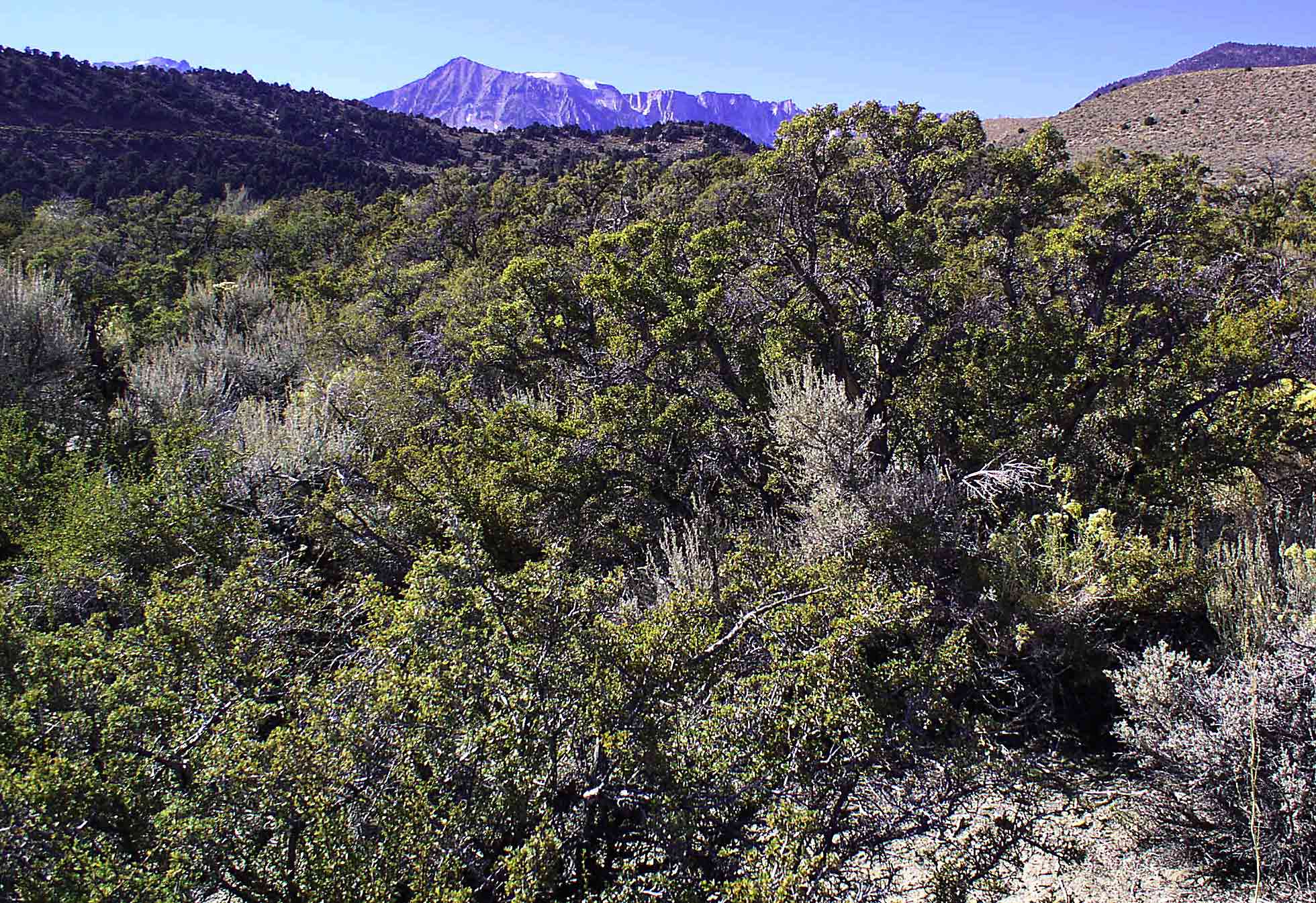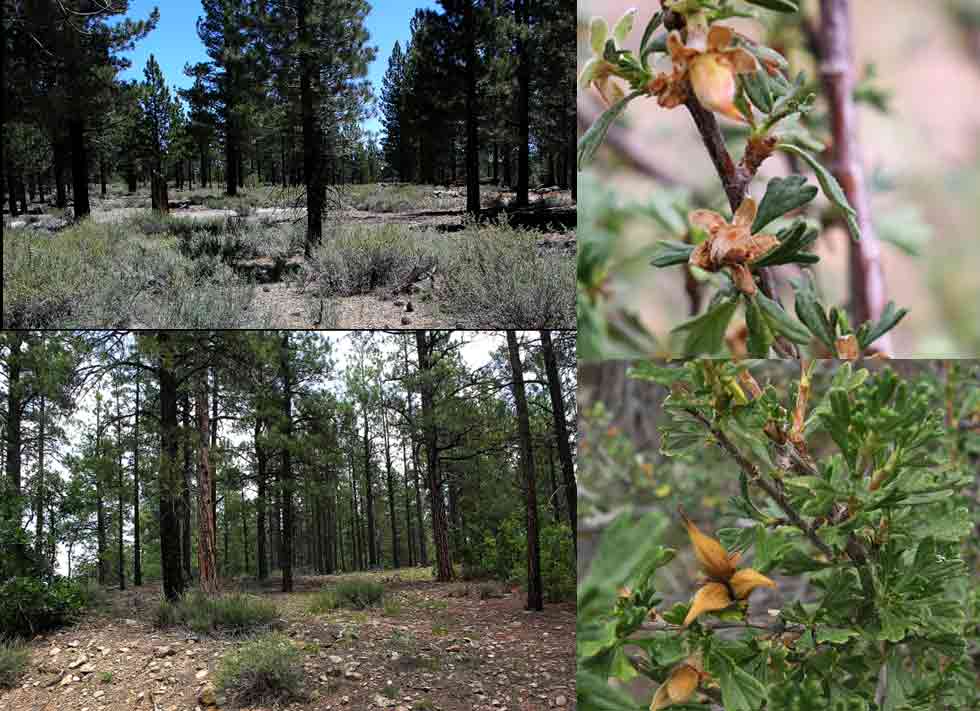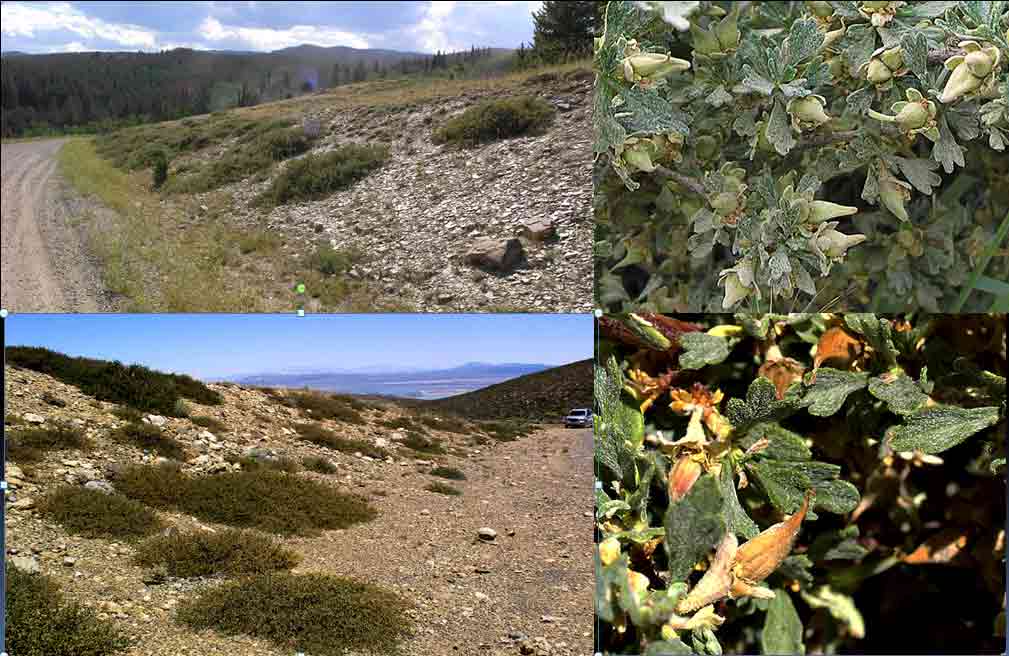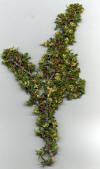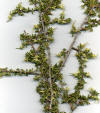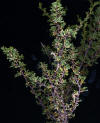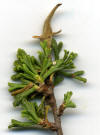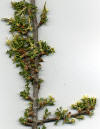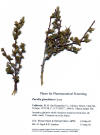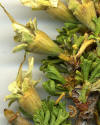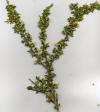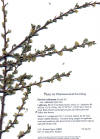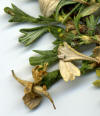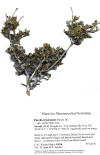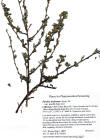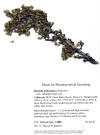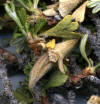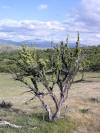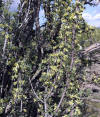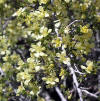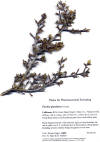|
Purshia is suggested to comprise two species, P. glandulosa and P. tridentata. .The latter species (P. tridentata) can be divided into varieties as appearing correlated with vegetation types, examples follow:
(1). An arborescent variety that forms dense forests or thickets along the California/Nevada state line from Mono County to Lassen County, generally characterized by leaves born on short spur shoots, but is also common east in the Great Basin Desert as scattered individuals or colonial.
(2) A small hummock variety that is a common understory component of ponderosa pine (and Jeffrey pine) forests in eastern Sierra Nevada of California, eastern Cascades of Oregon, and southern Rocky Mountains. The image above, top half, from Mono County east off Hwy 395, south of Deadman Summit; shrubs ~50 cm high and broad in Jeffrey pine forest, with close-up of single carpelled fruit (July 4, 2007). Lower half in a ponderosa pine forest in southwestern Colorado, San Juan Mts., Archuleta Co., between Durango and Pagosa Springs, Forest Road to Devils Peak, ~ 2 miles north of Hwy 160, and close-up of a plant with a three-carpelled fruit (July 29, 2008).
(3) A subalpine mat variety widely distributed from eastern California to Wyoming. Top half along road in southwestern Wyoming, west of Sierra Madre, Continental Divide, ~3200 m (Aug 5, 2008). Bottom half along road to Virginia Lakes in Mono County, California, elev. ~2,500 m (Oct 26, 2006). Wyoming plants produce one or two fruiting carpels, in contrast to just one carpelled fruit in California plants. Other varieties include one that is a nondescript much-branched shrub common to the sagebrush desert, and (4) an arborescent variety scattered in Garry oak woodland that differs in not having distinct leafy spur shoots. One other variety with reddish twigs occurs in the transition of the Mohave Desert to the Great Basin Desert. Cowania is distinguished from Purshia by the multiple fruit, each fruiting carpel with a plumose style. Below are tentative species and varieties distinguished as follows:
Trees and Shrubs of Kern County (Dec 2012, Aug 2016) Purshia. Shrubs or small trees; leaves usually persistent for one or more seasons, in alternate clusters, lacking petioles, usually at ends of short spur shoots, wedge-shaped in outline—widest near apex, tapered to base, terminally 3-lobed or incised. Flowers white or cream, solitary on short branches, with a green funnel-like hypanthium, browning with age, sepals 5, spreading from rim of hypanthium, persistent; petals 5, alternate with sepals, soon deciduous, narrowed to a claw-like base where attached to hypanthium rim; stamens ~25 in one series; gynoecium apocarpous, of solitary to several free carpels, not all flowers producing carpels but all with stamens; ovary enlarging in fruit, expanding beyond the hypanthium, thus exposed, style persistent. Fruit a camara, or camaretum when more than one carpel in a flower matures, freely dispersed from the plant intact (indehiscent), the seed free from the papery pericarp, easily dislodged. 2 spp., western North America. The fruit of Purshia is a camara (or camaretum if more than one carpel), generally referred to as an achene in the taxonomic literature (Henrickson. 2015); however, the pericarp is often ribbed and firm with a shape similar to but different from that of the seed. Camara is the appropriate term for a simple free carpelled indehiscent fruit or fruitlet (Mirbel 1815; de Candolle 1819; Jackson 1900; see Spjut 1994 for complete reference citations and discussion). In the related genus Cowania (Erikkson et al. 2003), the mature pericarp adheres tightly to the seed, thus, the pericarpium conforms to the definition of an achene (Spjut 1994), which in Cowania further differs by the style elongating and becoming feathery, undoubtedly wind dispersed (USDA Forest Service 1948). The Purshia fruit evidently evolved from a Cowania gynoecium by reduction in number of carpels and by adaptation to dispersal by rodents, notably chipmunks (Vander Wall 1994). Besides differences in the fruit, Cowania differs by the ovaries maturing within the hypanthium, and by having stamens in two series. A phylogenetic analysis of ITS sequences, showed Purshia in a separate clade, derived from Cowania, which included C. mexicana, C. subintegra, and C. stansburiana in one clade, and C. ericifolia, and C. plicata in another (Jabbs 2000). Prior to the Jepson Manual (Hickman edition, 1993 ), Purshia included just one other species, P. glandulosa Curran (Jepson1925), both commonly known as northern antelope bush and Mojave antelope bush, respectively, in regard to their separate geographical ranges and their importance as food to antelope and deer (Abrams 1944). Northern antelope bush (P. tridentata) is primarily found in the Great Basin and Rocky Mt. regions, and Mojave antelope bush (P. glandulosa), as its name implies, in the Mojave Desert; both occur in Kern County. However, they have since become one species and two varieties of just bitter brush (P. tridentata), because they allegedly hybridize with the closely related Cowania stansburyana where their geographic ranges overlap (Stutz & Thomas 1964). Their alleged introgression (Stebbins1959) led to the downfall of Cowania (Henrickson1986); its six species were added to Purshia. One in Arizona, P. subintegra, developed an identity crisis for its promiscuity with P. stansburyana. Purshia subintegra, an endangered species, that may lose protection status (Travis et al. 2008). The plants are not entirely to blame, however, human disturbances to their habitats have been implicated (Baggs & Maschinski 2000). Although hybridization is reportedly common where the rosaceous species overlap geographically, I have rarely seen the hybrids in my travels. Moreover, Jepson (1936) noted that the alleged “hybrid between Cowania mexicana var. stansburiana [sic]and Purshia tridentata,” “variety dubia Bdg.” [Brandegee], was “rarely collected,” known then from the Providence Mts., CA and Morey Peak., NV (Jepson citing Brandegee in Zoe 5: 149, 1903, emphasis added). “Cowania differs from Purshia in so many striking characteristics that hybrids and hybrid derivatives are easily detected in the field” (Stutz & Thomas 1964). Therefore, it seems unreasonable to recognize P. subintegra since it is a genetically modified species as a result of being hybridized over most of its range (P. x subintegra)—when other Purshia and Cowania species not recognized—are distinct over most of their range (Spjut, Mimulus Memo, Sep 2016).
Key to the Species of Purshia
Leaves rolled under to mid region, appearing mostly green underneath,
Leaves rolled under along margins, appearing white hairy underneath, Purshia glandulosa Curran 1885 [Purshia tridentata (Pursh) DeCandolle var. glandulosa (Curran) M.E. Jones 1895]. Mojave antelope bush, Desert bitter brush. Evergreen shrub or small tree to 5 m or more high, bark fibrous on tree forms, twigs often reddish brown or maroon, aging with whitish gray streaks between rectangular to square bark platelets, eventually whitish gray stems, glandular stipitate or not glandular on leafy twigs, glands pale reddish brown; spur shoots with imbriate triangular (deltoid) scales in 1–4 or more series; leaves evergreen, clustered at tips on short spur shoots, wedge-shaped, 4–12 mm long, widening from narrow base, terminally 3 (-5)-lobed, deeply inrolled from margins to near midrib—the lobes and main blade all appearing nearly terete in cross section, creased where they meet on the undersurface, the lobes much like fingers, spreading unevenly, the middle lobe (index finger) more flexed, appearing as if giving one the finger!, tipped with a soft transparent often deflexed whitish mucro, strongly resinous—by transparent oil-like droplets (exudate) on upper and side surfaces from glandular punctures (cavity-like depressions), white cottony hairs usually seen underneath between inrolled margins or along midrib; flowers Apr-Jun, white to cream, the petals soon deciduous, sepals spreading to reflexed; hypanthium funnelform, slightly to conspicuously plicate (pleated), often with very short spreading hairs, occasionally with surface oil glands. Fruit: camara with a persistent curved or deflexed style, pericarpium appearing more sharply differentiated from persistent style with age, slightly to conspicuously plicate, densely hairy, the hairs spreading to ± appressed upwards, falling freely from hypanthium during summer. Eastern slopes of the Sierra Nevada along the western margins of the Mojave and Great Basin deserts, extending east in the Mojave region to Nevada and Arizona. Type: Mohave side of Tehachapi Pass, Kern County, California, U.S.A; May & July 1884. Type specimen undetermined? Note: Other specimens by Curran from the same general locality have included fragments such as that for Tetradymia stenolopis at NY and at GH. M. K. Curran, Bull. Calif. Acad. Sci. 1(3): 153, 1885. CA. Bitter brush scrub recognized in MCV2 without distinction to variety when ≥5% absolute cover to other important species in the shrub canopy, especially Artemisia tridentata or Ericameria nauseosa, or ≥5% absolute cover in the shrub canopy in which Ephedra viridis <1% cover, while A. tridentata may codominate. Kern Co.: Common along the Pacific Crest trail at Walker Pass and just south of Kelso Valley. Further noted by Twisselmann to extend to the Dry Canyon in the Mt Pinos region in Ventura Co, 950–1,677 m (CCH). Native Americans east of Bakersfield (Kawaiisu) used the plant for menstrual cramps, and the inner bark and leaves as an emetic, a laxative, and for treating gonorrhea (Moerman). Although treated as a variety of P. tridentata in JM1 &2, and FNA, P. glandulosa is here recognized a distinct species as in California floras preceding JM1. The basis for uniting the two species has been alleged hybridization and introgression where the species come into contact. Twisselmann indicated that ranges of the two species in Kern County apparently do not overlap, stating they are narrowly separated in the region along the South Fork of the Kern River, but suggested that plants in Kelso Canyon at the east base of Piute Mt. show characteristics of introgression. Purshia tridentata (Tigarea tridentata Pursh , Flora Americae Septentrionalis 333,1814) DeCandolle 1817, Trans. Linn. Soc. London 12: 158. Northern antelope brush; bitter brush. Semi-deciduous shrub or small tree to 5 m or more high, bark fibrous on tree forms, or like manzanita on some sparingly branched shrub forms in Utah, twigs reddish or maroon, or gray, with or without glandular hairs; spur shoots covered with triangular (deltoid) imbricate scales in 1–4 or more series at base, often branched in tree forms, scales sometimes fringed along margins; leaves both persistent and winter deciduous (Henrickson in FNA 9, 2015, dimorphic), one or more clusters near ends of spur shoots, wedge-shaped in outline, narrowed at base, gradually widened above, 15 –50 mm long, terminally 3-lobed, the lobes mostly plane, not tubular, rounded to acute to mucronate to apiculus, or apiculus not evident; upper leaf surface pale green with white appressed hairs, sometimes with many additional white cottony patches, or blisters, pustulate but not punctate, with or without surface oil glands near margins especially near base, or shiny green without hairs, inrolled along margins, the undersurface with a wide region of white cottony hairs between shallow inrolled margins; flowers Apr–Jun, white to cream, the petals soon deciduous; sepals spreading to reflexed from rim of hypanthium, generally more rigid than P. glandulosa, often shortly fringed and sometimes curled along margins with age; hypanthium variable in pubescent features, appearing felt-like with surface glands, or with stipitate glands, or just short hairy. Fruit: camara or camaretum, persistent into late summer, falling separate from the more persistent hypanthium with a persistent curved style, densely short hairy. Great Basin and Rocky Mt. regions, eastern Sierra Nevada along the western margins of the Mojave and Great Basin deserts to BritishColumbia, extending east to the Rocky Mountains plains, Montana, Colorado. Type from the Mojave side of Tehachapi Pass [Kern Co.], CA. Bitter brush scrub (alliance) recognized in MCV2, without distinction to variety, when ≥5% absolute cover to other important species in the shrub canopy, especially Artemisia tridentata or Ericameria nauseosa, or ≥5% absolute cover in the shrub canopy in which Ephedra viridis <1% cover, while A. tridentata may codominate.similar to the preceding, A widespread common species of the high deserts from California to New Mexico, and north to Montana and British Columbia. Type reported as a shrub common to the open prairie of the knobs, west of Lewis and Clark Pass, Lewis and Clark Co., Montana, , 6 Jul 1806. Kern Co.: Bartolas Country in the arid Jeffrey pine forest of the southern Kern Plateau, where scarce (Twisselmann); also in the Piute Mts. near Sorrel Peak, 2134 m (Shevock 16 May 1981, CAS; Spjut s.n., 14 Jun 2016, WBA) and Claraville Flat (6,200–6,300 ft, C. N. Smith 29 Aug 1943, JEPS), 2134–2195 m (CCH). Purshia tridentata has been used by native Americans throughout its range, although uses vary by culture. Plant parts and their uses include root for coughs, as an emetic, febrifuge, for lung and bronchial troubles, fever, facilitate child birth; bark for tuberculosis, lung pain, and gonorrhea; leaves as an emetic, laxative, for colds, pneumonia, venereal diseases, intestinal worms, constipation, stomachaches, skin problems, rash, and fruits as an emetic, or the entire plant taken to treat chicken pox, smallpox, measles, and other uses already mentioned (Moerman). Samples of root and twig-leaves with flowers collected by USDA Agricultural Reseaarch Botanist A. S. Barclay from California in July 1962 were screened by the NCI and found active in the KB assay (0.21, 0.14); however, the species was dropped from investigation due to insufficient activity in recollections investigated by Pfizer in 1965. A root sample collected by Spjut in Oct 1989 was active in a antitumor bioassay employed by Dr. Ching-jer Chang at Purdue University, but a recollection made the following year, June 1990, from the eastern Cascades Washington, failed to reconfirm. Purshia tridentata is treated separately from P. glandulosa and includes several or more varieties that appear related to thier occurrence in vegetation types. These include (1) a low shrub with wide spreading branches that is a major understory component of pine forests from California to British Columbia, and east to Colorado, (2) an arboreal type found in the open sagebrush deserts, sometimes forming dense shrubland or forest stands, and (3) a much-branched shrub nearly prostrate (flat on the ground) in the subalpine deserts, and a much-branched shrub of various forms at lower elevation sagebrush desert. Intermediates may be segregated by differences in branching of spur shoots, in the color of twigs, and by different pubescent features on leaves, hypanthia and fruits. .
| References Abrams, L. 1940–1960 [Abrams]. Illustrated Flora of the Pacific States, Vol. I. (1923), Vol. II (1944), Vol. III (1951, with R. Ferris, Vol. IV (1960 with R. Ferris). Stanford Univ. Press. Alderfer, J.M. 1976. A taxonomic study of bitterbrush (Purshia tridentata [Pursh] DC.) in Oregon. Master’s thesis, Oregon State University, Corvallis, OR. Baggs, J.E. and J. Maschinski. 2001. The threat of increasing hybridization of an endangered plant species, Purshia subintegra, in the Verde Valley, Arizona. Pages 213–220 in J. Maschinski and L. Holter, technical coordinators, Southwestern Rare and Endangered Plants: Proceedings of the Third Conference. Proceedings RMRS-P-23, USDA Forest Service, Rocky Mountain Research Station, Fort Collins, CO. Available from: www.treesearch.fs.fed.us/pubs/29225. Eriksson, T., M. S. Hibbs, A. D. Yoder, C. F. Delwiche, and M. J. Donoghue. 2003. The phylogeny of Rosoideae (Rosaceae) based on sequences of the internal transcribed spacers (ITS) of nuclear ribosomal DNA and the TRNL/F region of chloroplast DNA. Int. J. Plant Sci. 164(2):197–211. Henrickson, J. 1986. Notes on Rosaceae. Phytologia 60: 468. Henrickson, J. 2015. Purshia. In FNA, Rosaceae, Vol. 9 (eFlora). Ito H., M. Miyake, E. Nishitani, K. Mori, T. Hatano, T. Okuda, T. Konoshima, M. Takasaki, M. Kozuka, T. Mukainaka, H. Tokuda, H. Nishino and T. Yoshida. 1999. Anti-tumor promoting activity of polyphenols from Cowania mexicana and Coleogyne ramosissima. Cancer Lett. 143(1): 5–13. “Chemical investigation on polyphenol-rich fractions of Cowania mexicana and Coleogyne ramosissima (Rosaceae) which showed significant inhibitory effects on Epstein-Barr virus early antigen (EBV-EA) activation induced by 12-O-tetradecanoylphorbol-13-acetate (TPA), has led to the characterization of 10 compounds including C-glucosidic ellagitannin monomers and dimers from the former plant, and 17 polyphenols including flavonoid glycosides from the latter. The effects of individual components and their analogues with related structures on the TPA-induced EBV-EA activation were then evaluated. Among the compounds isolated from C. mexicana, two C-glucosidic ellagitannins, alienanin B and stenophyllanin A and a nitrile glucoside (lithospermoside), and among the constituents from C. ramosissima, two flavonoid glycosides, isorhamnetin 3-0-beta-D-glucoside and narcissin were revealed to possess strong inhibitory effects on EVB-EA activation, the potencies of which were either comparable to or stronger than that of a green tea polyphenol, (-)-epigallocatechin gallate. These polyphenols except for nitrile glucoside, which was not tested owing to an insufficient amount, were also found to exhibit anti-tumor promoting activity in two-stage mouse skin carcinogenesis using 7,12-dimethylbenz[a]anthracene (DMBA) and TPA.” Jabbes, M. 2000. Hybridization and its evolutionary consequences in Purshia and Cowania. Doctoral dissertation, University of Idaho, Moscow, ID [briefly summarized in R. L. Pendleton, E. Durant McArthur, and S. C. Sanderson. 2012.. Breeding system and interaccessional hybridization of Purshia tridentata plants grown in a common garden. West.N. Am. Naturalist 72: 241–249]. Jepson, W. L. 1909–1943 A Flora of California. University of California, Berkeley. Vol. 1 (Pt. 1&2–1922,), 2 (1936), 3 (Pts 1 &2–1939), and Lauramay Dempster , Rubiaceae, Vol. 4, Pt 2 (1979). Jepson, W. L. 1923, 1925. A Manual of the Flowering Plants of California. University of California Press. Jepson Manual (JM1). The Jepson Manual, 1993, edited by J. C. Hickman. University of California Press, Berkeley, Los Angeles, and London [6,885 native and naturalized species, 200+ contributors]. Konoshima T, M. Takasaki, M. Kozuka, M. Haruna, K. Ito, J. R. Estes and K. H. Lee. 1993. Constituents of rosaceous plants. I. Structure of new triterpenoids from Cowania mexicana. Chem. Pharm. Bull. (Tokyo) 41(9): 1612–615. In our search for possible anti-tumor-promoters, we carried out an investigation of the leaves and branches of Cowania mexicana D. DON (Rosaceae). Two new cucurbitane type triterpenes, 15-oxo-cucurbitacin F (3) and 15-oxo-23,24-dihydrocucurbitacin F (4), were isolated together with cucurbitacin F (1) and 23,24-dihydrocucurbitacin F (2). These triterpenes were inhibitors of Epstein-Barr virus early antigen activation induced by 12-O-tetradecanoylphorbol-13-acetate, a well-known tumor-promoter. The structures of 3 and 4 were determined from 2D-NMR spectral data and difference NOE experiments. Spjut, R. W. 1994. Systematic treatment of fruit types. Illustrations by Karen Parker. Memoirs of the New York Botanical Garden 70, 181 p. Stebbins, G. L. 1959. The role of hybridization in evolution. Proc. Am. Phil. Soc. 103: 231–251. Stutz, H.C., and L. Kay Thomas. 1964. Hybridization and introgression in Cowania and Purshia. Evolution 18: 183–195. Swensen, S. M. 1996. The evolution of actinorhizal symbioses: evidence for multiple origins of the symbiotic association. Am. J. Bot. 83: 1503–1512. Travis, S. E., J. E. Baggs and J. Maschinski. 2008. Disentangling the role of hybridization in the evolution of the endangered Arizona cliffrose (Purshia subintegra; Rosaceae): A molecular and morphological analysis. Conservation Genet. 9: 1183–1194. USDA Forest Service. 1948. Woody seed plant manual. Misc. Publ. 564. Vander Wall, S. B. 1994. Seed fate pathways of antelope bitterbrush: Dispersal by seed-caching yellow pine chipmunks. Ecology 75: 1911-1926. Young, J. A. and C. D. Clements. 2002. Purshia: The Wild and Bitter Roses, University of Nevada Press, Reno.
|
